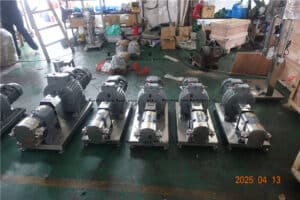In the intricate choreography of industrial operations, where the precise and careful movement of fluids is often paramount, the lobe pump emerges as a foundational technology. As a distinguished member of the positive displacement pump family, its unique design and operational characteristics have cemented its status as an indispensable asset across a vast spectrum of sectors. From the delicate handling required in biotechnology to the robust demands of chemical transfer, the lobe pump consistently delivers, ensuring product integrity and operational efficiency.
Engineering Excellence: The Precision Mechanics of a Lobe Pump
The operational finesse of a lobe pump stems from a sophisticated interplay of mechanical components designed for specific precision. At its core are two non-contacting, counter-rotating lobes, housed within a close-tolerance casing. What truly distinguishes its mechanism is the reliance on external timing gears, located in a separate gearbox, to synchronize the rotation of these lobes. This crucial engineering detail ensures that the lobes rotate in perfect harmony without ever touching each other or the pump housing. This lack of metal-on-metal contact within the fluid chamber is fundamental to the pump’s ability to handle shear-sensitive fluids, suspended solids, and viscous materials with minimal damage or degradation.
The pumping cycle begins as the rotating lobes move away from the suction port, creating an expanding volume that draws fluid into the pump. As the lobes continue their synchronized rotation, they trap discrete pockets of fluid between the lobe surfaces and the pump casing. This trapped fluid is then positively displaced as the lobes re-mesh at the discharge port, forcing the fluid out under pressure. The consistent displacement of a fixed volume per revolution results in a smooth, near-pulsation-free flow, a critical attribute for applications requiring steady delivery or accurate metering. The careful design of the clearances between the lobes and the casing, as well as between the lobes themselves, is paramount to maintaining pumping efficiency while minimizing slippage, especially with lower viscosity fluids.
Strategic Selection and Performance Optimization
Selecting the appropriate lobe pump is a critical decision that directly impacts operational efficiency and product quality. Key performance metrics such as flow rate, discharge pressure, fluid viscosity, and temperature are paramount considerations. The relationship between these factors dictates the specific pump size, lobe configuration (bi-lobe, tri-lobe, or multi-lobe), and drive speed. For instance, higher viscosity fluids often require lower pump speeds to prevent cavitation and ensure effective filling of the lobe cavities.
Net Positive Suction Head (NPSH) calculations are also crucial to prevent cavitation, which can lead to reduced efficiency, increased wear, and operational noise. A well-designed system will ensure adequate NPSH available to the pump. Furthermore, the construction materials of the lobe pump must be compatible with the fluid being transferred, considering factors like corrosiveness, abrasiveness, and temperature. For sanitary applications, materials like 316L stainless steel are standard, ensuring chemical resistance and ease of cleaning. Reputable manufacturers like ACE LOBE PUMP often provide detailed specifications and offer expert guidance to ensure optimal pump selection for diverse industrial needs, highlighting their adherence to international standards like CE and ISO 9001.
Upholding Standards: Hygiene and Regulatory Compliance
In sectors such as food, pharmaceutical, and biotechnology, the lobe pump’s design for hygiene and ease of cleaning is a significant advantage. Many models are specifically engineered for Clean-In-Place (CIP) and Sterilize-In-Place (SIP) processes, allowing for thorough cleaning and sanitation without disassembling the pump. This capability is vital for preventing cross-contamination and adhering to stringent regulatory requirements set by bodies like the FDA and organizations like 3-A Sanitary Standards Inc.
Achieving hygienic compliance involves more than just material selection; it extends to surface finish, design that eliminates dead spaces or crevices where bacteria can harbor, and easy accessibility for inspection. The non-contacting nature of the lobes further contributes to hygiene by minimizing particle generation from wear. This meticulous attention to sanitary design makes the lobe pump a preferred choice where product purity and safety are non-negotiable.
Maintenance Best Practices and Lifecycle Value
While the lobe pump is renowned for its robustness and reliability, proactive maintenance is key to maximizing its operational lifespan and minimizing total cost of ownership. Key maintenance practices include regular inspection of seals, checking timing gear lubrication, and monitoring for unusual noises or vibrations. Because the lobes do not touch, wear on these primary pumping elements is minimal, often leading to extended service intervals. However, seals are wear parts and require periodic replacement based on operating conditions and fluid characteristics.
Addressing minor issues promptly can prevent larger, more costly repairs. The external bearing design common to lobe pumps allows for easier servicing and replacement of bearings and seals without disturbing the wet end of the pump, simplifying maintenance procedures and reducing downtime. Investing in high-quality pumps from manufacturers committed to durability, coupled with a sound maintenance strategy, translates into significant long-term savings through reduced energy consumption, minimized product loss, and consistent operational uptime.
Innovation and Future Trajectories
The evolution of the lobe pump continues, driven by demands for greater efficiency, intelligent control, and broader material compatibility. Innovations include advancements in lobe geometries for improved flow and reduced pulsation, development of new composite materials for enhanced chemical resistance and wear properties, and integration with advanced automation and monitoring systems. Smart pump technologies, incorporating sensors for vibration, temperature, and pressure, allow for predictive maintenance, further enhancing reliability and reducing unforeseen downtime. As industries move towards more sustainable and data-driven operations, the lobe pump is adapting, reinforcing its role as a fundamental, yet evolving, component in fluid transfer. Its enduring value lies in its proven capacity to deliver precision and reliability, critical attributes that will continue to drive its adoption in diverse industrial landscapes worldwide.
